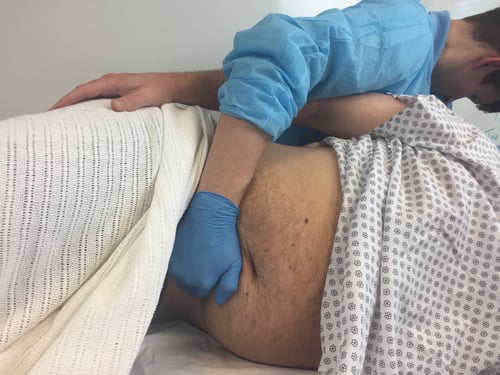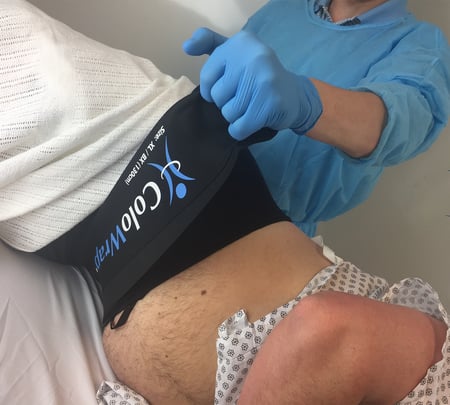5 Indirect Costs of Endoscopy Staff Injury: #5 Compliance
by Larissa Biggers, on June 14, 2019
If you have followed the previous four posts in our series on indirect costs of endoscopy staff injury, you know that musculoskeletal disorders (MSDs) sustained on the job are costly. Case in point: the Occupational Safety and Health Administration (OSHA) estimates that one of every three dollars spent on workers’ compensation claims originates with ergonomic problems, and costs related to MSDs amount to more than $54 billion per year. This article, which is the last in the series, looks at how MSDs affect an organization’s ability to comply with worker safety regulations and the financial consequences of violations.
 Risky patient handling during colonoscopy
Risky patient handling during colonoscopy
Ergonomic Safety Standards
OSHA’s mission is to guarantee safe working conditions for employees. To meet this goal, it establishes standards, for instance, requirements to protect workers from exposure to harmful substances. OSHA's General Duty Clause compels employers to keep workplaces free from recognized serious hazards; these include ergonomic ones. To enforce its standards, OSHA can inspect facilities at any time.
Planned inspections are the most common type of visit to hospitals and typically occur as a result of a significant number of work-related injuries and illnesses recorded on OSHA 300 logs. They can also originate with a specific event or hazard or in response to an employee or patient complaint. For example, an OSHA inspection would be warranted in the following situation.
In one calendar year at a regional hospital, two endoscopy nurses and three technicians suffered musculoskeletal injuries as a result of assisting with colonoscopy. All were out of work for three or more days, and even after surgery and extensive physical therapy, one of the nurses was not able to return to work at all. All of these events were reported on OSHA 300 logs.
In this example, OSHA inspectors would determine if: one or more ergonomic hazards exist (e.g., no access to SPHM technology to mitigate risk of injury); the hazards are recognized; the hazards are causing or are likely to cause serious physical harm to employees; and a reasonable means exists to reduce the hazards.
Fines for Safety Violations
OSHA can impose penalties of up to $13,260 for each “serious” or “other-than-serious” violation, for instance, an ergonomics hazard related to patient transfer. Facilities are expected to address issues that have been identified; in this case, the hospital could conduct a worksite analysis, implement SPHM technology like slide sheets and mechanical lifts, and mandate training. If it does not, a “failure to abate” penalty of $13,260 per day can be levied. Facilities with willful or repeated violations can be charged up to $132,598 per violation.
 SPHM technology to mitigate the risk of staff injury during colonoscopy
SPHM technology to mitigate the risk of staff injury during colonoscopy
Like worker’s compensation claims, fines for safety violations can be steep and can also sully the reputation of a hospital, scaring away patients and potential employees.
Steps toward Stricter Enforcement
OSHA recently proposed adding a separate column on the OSHA 300 log for employers to record work-related MSDs to better highlight this data. It also issued new hospital guidance for implementing patient and worker safety programs. When investigating complaints or incidents, OSHA can use this guidance to argue that a facility knew about the hazards employees face and measures it could have taken to control them. Finally, it created a publicly available database that allows users to search for information on inspections, violations, and much more. These actions on the part OSHA raise awareness about worker safety and could indicate a renewed focus on ergonomics policies and enforcement.
The Long Road to Safety
Despite efforts by OSHA and a few states that have passed healthcare safety legislation, most healthcare facilities are not yet able to guarantee the safety of staff. Organizational leaders must be invested in promoting a culture of workplace safety and be willing to allocate the time and funding necessary. Doing so will likely mean fewer worker's compensation claims and OSHA violations and healthier, more resilient employees.


